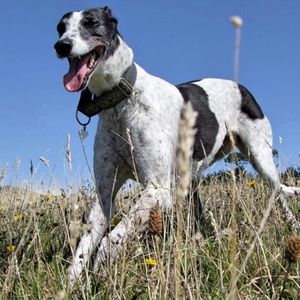Update on Alabama Rot and Seasonal Canine Illness
21 February 2018
Professor Steven Dean is Chairman of the Greyhound Trust and Head of the Veterinary and Welfare Committee
Please remember that if you are at all concerned about the health of your greyhound to consult your vet immediately in the first instance.
Alabama Rot
With the more technical name of idiopathic cutaneous and renal glomerular vasculopathy (CRGV) this is a seasonal illness with the potential to be fatal. It was first identified in the USA during the 1980s in greyhounds (the colloquial name is a clue to where it first occurred).
The initial symptoms are sores or ulcers on the legs, chest and abdomen followed by signs of kidney damage. It is reported that the underlying pathology reveals damage to skin and kidneys caused by a blood clotting disorder in the small blood vessels.
The consequential disruption of the blood supply results in areas of ulceration of the skin and reduced function in the kidneys. Because the kidneys seem to be affected quite severely, a catastrophic loss of renal function is highly likely and although the number of cases is low the likelihood of death in those cases is high.
The underlying cause has not been identified but wet and muddy environmental conditions seems to be an important factor. As yet no specific infection has been identified.
This leads to general advice to wash your dogs legs and undercarriage to remove mud and dirt after a walk and at least wipe a dog clean after a wet or muddy walk, especially in woodland areas. Clinical cases are widely distributed throughout the country and there seems to be no justification for any assumption about regionality unless there is recent news of an area associated with an outbreak.

Regular examination after walking is recommended. Look for skin damage. This should become the norm after an active countryside walk. The sore inflamed areas typical of CRGV can be confused with cuts and abrasions so if there is any doubt seek veterinary advice quickly.
The principal concern is the potential for kidney failure. Less than 100 dogs were reported with severe skin lesions or renal failure between November 2012 and April 2017 there are no figures on deaths but some authors claim 9/10 affected dogs will die. Despite the low numbers of affected dogs CRGV is a serious illness which can best managed through prompt attention when symptoms occur.
The seasonality of the problem appears to be during winter and spring although cases have also occurred outside of these timelines.
Seasonal Canine Illness (SCI)
There is an illness in dogs which tends to occur during autumn although odd cases cases have occurred outside this seasonality. Given the way the UK climate has been developing recently the differentiating line between autumn and winter is becoming less easy to determine and it is assumed this illness is subject to climatic conditions.
The seasonality suggests a specific agent is the cause but so far nobody has determined what the underlying cause of the illness might be, although there is some suspicion that harvest mites might be part of the profile.
Another apparent characteristic of SCI is an association with dogs being walked in woodland areas. The clinical symptoms, however, are not highly specific as the illness presents with vomiting, diarrhoea and lethargy. These are the signs associated with several forms of gastrointestinal upset and most owners will assume their dogs ‘has eaten something disagreeable’. It may well have, but SCI appears to be a far more serious condition compared to a ‘gastric upset’. An affected dog may also have any combination of abdominal pain, a fever and muscular tremors.
The vomiting and diarrhoea can rapidly lead to dehydration and cases with severe symptoms, suffered for several days, may collapse and die if not treated effectively. Nevertheless, most cases will recover over a 7-10 day period which is assisted by effective re-hydration therapy, which in the early stages may demand an intravenous drip and intensive care. Thus where SCI occurs early veterinary assistance is sensible.
The underlying cause of SCI remans elusive and given the autumn seasonality and specific regional associations with woodland walks these should be key features in a diagnosis. The clinical signs are usually seen within three days of having roamed in a woodland area. Thus advice on prevention is fairly non-specific and recommendations are limited as follows:
• Be vigilant
Closely monitor your dog’s health in the hours and days after a woodland walk, especially if you normally do not walk your dog(s) in the area (i.e. you are on holiday).
• Use a lead
Keep your dog on a lead during a woodland walk so that you can keep an eye on them at all times.
• Don’t hesitate
Go to your vet immediately if you think your dog could have SCI - prompt veterinary attention could make the difference between life and death. If dogs get veterinary treatment quickly, they tend to recover well after a week or so.
• Keep hydrated
Make sure your dog is offered water before you set off on foot, especially if you have travelled a long way in the car for your walk. Keeping hydrated may help if your dog is affected by SCI and may prevent your dog from drinking from standing water.
• Think about mites
Harvest mites have been commonly noted on dogs suffering from SCI, so it may help to preventatively spray dogs against mites before a walk. It is important to use a spray rather than a ‘spot-on’ product as the chemical barrier of a spray may be more effective at preventing a mite infestation and can be applied directly to the more exposed areas of the feet, legs, chest and belly. Your vet will be able to advise on the correct products.
• Tell others
Help to raise awareness of the disease amongst fellow dog owners.
This advice is provided by the Animal Health Trust although their advice is vague about the spray recommended for prevention of Harvest Mites (sometimes called “chiggers”) but it is in fact all spray formulations containing fipronil. This is largely because using this product for preventing harvest mite infestations is not an authorised use and does not therefore appear on the product labelling, thus should be prescribed by a veterinary surgeon.
Remember, if you are at all concerned that your greyhound may be unwell, you should always consult your vet immediately.